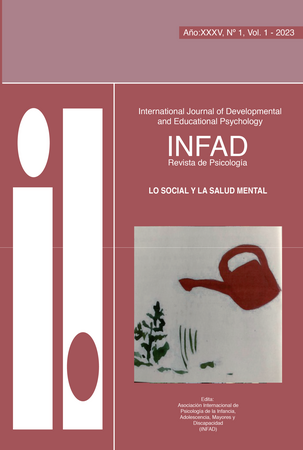Sexismo en chicas adolescentes: análisis comparativo entre población general y de medidas judiciales
Contenido principal del artículo
Resumen
El sexismo es definido como una actitud de animadversión y discriminación dirigida hacia las personas en base a su categoría sexual o género, sustentando las relaciones de desigualdad entre hombres y mujeres. Glick y Fiske (1996), en su teoría del sexismo ambivalente, lo conceptualizan como un constructo bidimensional conformado por el sexismo hostil y el sexismo benevolente. Asimismo, la adolescencia ha sido identificada como una etapa evolutiva clave en el desarrollo de creencias y manifestaciones sexistas, existiendo evidencia acerca de mayores niveles de sexismo en poblaciones vulnerables. Por ello, el presente estudio tiene por objetivo comparar actitudes sexistas entre dos grupos de mujeres adolescentes: las que se encuentran bajo medidas judiciales (MJ) y población general (PG). Para ello se diseñó un estudio cualitativo mediante el uso de la técnica focus group en el que participaron un total de n=13 mujeres adolescentes con un rango de edad de entre 16 y 19 años, creando dos grupos focales en función de su contexto -MJ y PG-. A partir del análisis del discurso se identificó una predominancia del sexismo hostil en el grupo MJ, mientras que el grupo de PG presentó una mayor ambivalencia y equilibrio entreactitudes hostilesy benevolentes. En este sentido,en elsegundo grupo se detectó una mayor conciencia y crítica hacia actitudes sexistas, señalando en reiteradas ocasiones el rechazo hacia las mismas. Además, los argumentos ofrecidos por el grupo MJ evidencian la interiorización de diferentes mitos del amor romántico, entendiendo los celos como una muestra de amor y aceptando la compatibilidad de amor y maltrato en relaciones de pareja. Los resultados coinciden con hallazgos obtenidos en estudios cuantitativos sobre el mismo constructo e indican la pertinencia de implementar medidas preventivas a diferentes niveles, contemplando las necesidades específicas de poblaciones vulnerables. El presente estudio ha sido realizado en el marco de un proyecto financiado por la Conselleria d’Innovació, Universitats, Ciència i Societat Digital (Generalitat Valenciana) [AICO/2021/143].
Detalles del artículo
Sección

Esta obra está bajo una licencia internacional Creative Commons Atribución-NoComercial-SinDerivadas 4.0.
Aquellos autores/as que tengan publicaciones con esta revista, aceptan los términos siguientes:
- Los autores/as conservarán sus derechos de autor y garantizarán a la revista el derecho de primera publicación de su obra, el cuál estará simultáneamente sujeto a la Licencia de reconocimiento de Creative Commons que permite a terceros copiar y redistribuir el material en cualquier medio o formato bajo los siguientes términos: —se debe dar crédito de manera adecuada, brindar un enlace a la licencia, e indicar si se han realizado cambios. Puede hacerlo en cualquier forma razonable, pero no de forma tal que sugiera que usted o su uso tienen el apoyo de la licenciante (Atribución); — no se puede hacer uso del material con propósitos comerciales (No Comercial); — si se remezcla, transforma o crea a partir del material, no podrá distribuirse el material modificado (Sin Derivadas).
- Los autores/as podrán adoptar otros acuerdos de licencia no exclusiva de distribución de la versión de la obra publicada (p. ej.: depositarla en un archivo telemático institucional o publicarla en un volumen monográfico) siempre que se indique la publicación inicial en esta revista.
- Se permite y recomienda a los autores/as difundir su obra a través de Internet (p. ej.: en archivos telemáticos institucionales o en su página web) antes y durante el proceso de envío, lo cual puede producir intercambios interesantes y aumentar las citas de la obra publicada. (Véase El efecto del acceso abierto).

Este obra está bajo una licencia de Creative Commons Reconocimiento-NoComercial-SinObraDerivada 4.0 Internacional.
Cómo citar
Referencias
Bisquert-Bover, M., Giménez-García, C., Gil Juliá, B., Martínez Gómez, N. y Gil-Llario, M. D. (2019). Mitos del amor romántico y autoestima en adolescentes. International Journal of Developmental and Educational Psychology., 5(1), 507-518. https://doi.org/10.17060/ijodaep.2019.n1.v5.1633
Bonilla-Algovia, E., Rivas-Rivero, E.,y Pascual Gómez, I. (2021). Mitos del amor romántico en adolescentes: relación con el sexismo y variables procedentes de la socialización. Educación XX1, 24(2), 441-464. https://doi.org/10.5944/educXX1.28514
Carbonell, Á. y Mestre, M. V. (2018). Sexismo y mitos del amor romántico en estudiantes prosociales y antisociales. Prisma Social: revista de investigación social, (23), 1-17.
Díaz-Loving, R., González-Rivera, I. y Baeza-Rivera, M. J. (2019). Sexismo: una configuración a partir de las premisas histórico-psicosocioculturales. Enseñanza e Investigación en Psicología, 1(3), 287-293.
Fernández-García, O., Gil-Llario, M. D. y Ballester-Arnal, R. (2022). Prevalencia y caracterización del sexismo en el contexto español. Revista Contexto & Educação, 37(117), 118-127. https://doi.org/10.21527/2179-1309.2022.117.12980
Glick, P. y Fiske, S.T. (1996). The ambivalent sexism inventory: Differentiating hostile and benevolent sexism. Journal of Personality and Social Psychology, 70, 491-512. https://doi.org/10.1037/0022-3514.70.3.491
Glick, P. y Fiske, S. T. (2001). An ambivalent alliance: Hostile and benevolent sexism as complementary justifications for gender inequality. American psychologist, 56(2), 109-118. https://doi.org/10.1037/0003-066X.56.2.109
Jimenez-Picon, N., Romero-Martin, M., Romero-Castillo, R., Palomo-Lara, J. C. y Alonso-Ruiz, M. (2022). Internalization of the romantic love myths as a risk factor for gender violence: A systematic review and metaanalysis. Sexuality Research and Social Policy, 1-18. https://doi.org/10.1007/s13178-022-00747-2
Jimeno, M. V. y Canteto, M. J. (2020). Percepción de la violencia psicológica hacia la mujer en la relación de pareja y sexismo en adolescentes en acogimiento residencial: comparación con un grupo de adolescentes no institucionalizados. Revista Española de Investigación Criminológica, 18(1), 1-21. https://doi.org/10.46381/reic.v18i0.299
Madrona-Bonastre, R., Sanz-Barbero, B., Pérez-Martínez, V., Abiétar, D. G., Sánchez-Martínez, F., Forcadell-Díez, L., Pérez, G. y Vives-Cases, C. (2023). Sexismo y violencia de pareja en adolescentes. Gaceta Sanitaria, 37, 102221. https://doi.org/10.1016/j.gaceta.2022.02.007
Nebot-Garcia, J. E., García-Barba, M., Ruiz-Palomino, E. y Giménez-García, C. (2018). Sexo y amor: cuando la forma de entender el amor se convierte en un riesgo para la salud sexual de los jóvenes. Agora de salut, 5, 401-409. http://dx.doi.org/10.6035/AgoraSalut.2018.5.44
Salomon, K., Bosson, J. K., El-Hout, M., Kiebel, E., Kuchynka, S. L. y Shepard, S. L. (2020). The experiences with ambivalent sexism inventory (EASI). Basic and applied social psychology, 42(4), 235-253. https://doi.org/10.1080/01973533.2020.1747467
Slares Silva, I., Veloso, A. L. y Keating, J. B. (2014). Focus group: Considerações teóricas e metodológicas. Revista Lusófona de Educação, (26), 175-189.

